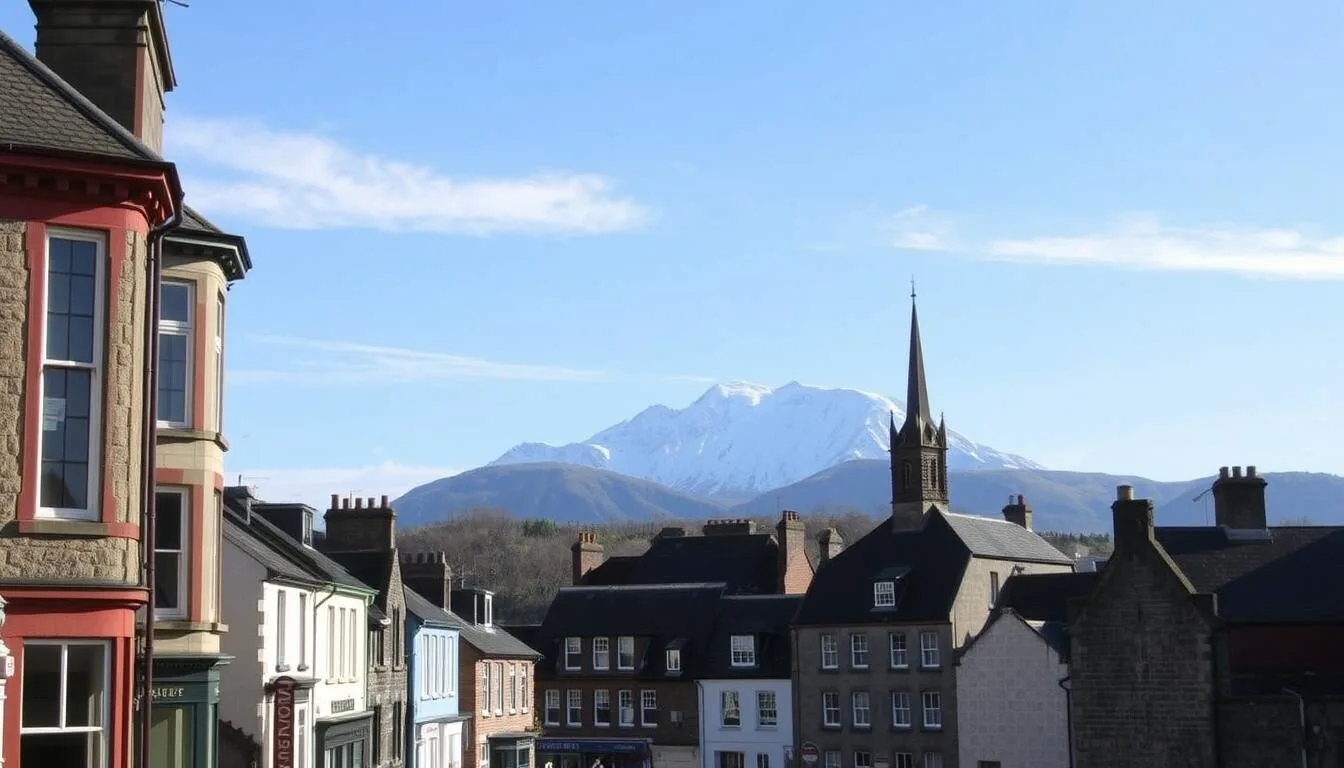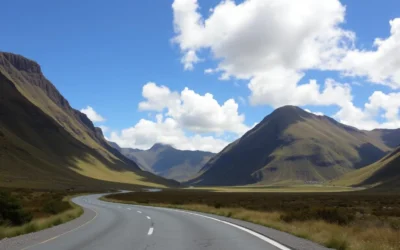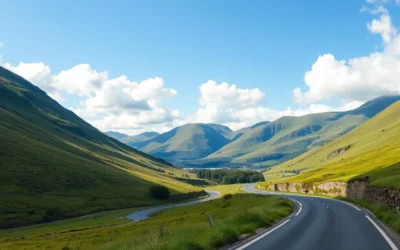Standing at 1,345 m (4,413 ft), Ben Nevis isn’t just Scotland’s highest peak—it’s a mountain with a fascinating secret. Once a massive active volcano, it exploded and collapsed inwards on itself millions of years ago, leaving behind the dramatic landscape we see today. This ancient giant, whose name translates from Gaelic as either “mountain with its head in the clouds” or “venomous mountain,” attracts over 125,000 walkers annually, making it one of Scotland’s most iconic natural attractions.
Getting There & Planning Your Journey
Fort William, known as the “Outdoor Capital of the UK,” serves as the gateway to Ben Nevis. Located in the western Scottish Highlands, this charming town is approximately 2-3 hours by car from Glasgow or 3-4 hours from Edinburgh.
By Air
The nearest major airports are Glasgow International (GLA) and Edinburgh Airport (EDI). From there, you can rent a car or take public transportation to Fort William.
Find the Best Flight Deals to Scotland
Compare prices from multiple airlines and book your flight to start your Ben Nevis adventure.
By Car
Driving to Fort William offers the most flexibility for exploring the area. The A82 is the main route, taking you through the stunning scenery of Loch Lomond and Glencoe before reaching Fort William.
Rent a Car for Your Highland Adventure
Explore Ben Nevis and the surrounding Highlands at your own pace with a rental car.
By Train
The scenic West Highland Line connects Glasgow to Fort William with trains running several times daily. For a truly special experience, the Caledonian Sleeper offers overnight service from London Euston to Fort William.
By Bus
CityLink operates direct bus services from Glasgow’s Buchanan Bus Station to Fort William, with the journey taking approximately 3 hours.
Best Time to Visit Ben Nevis
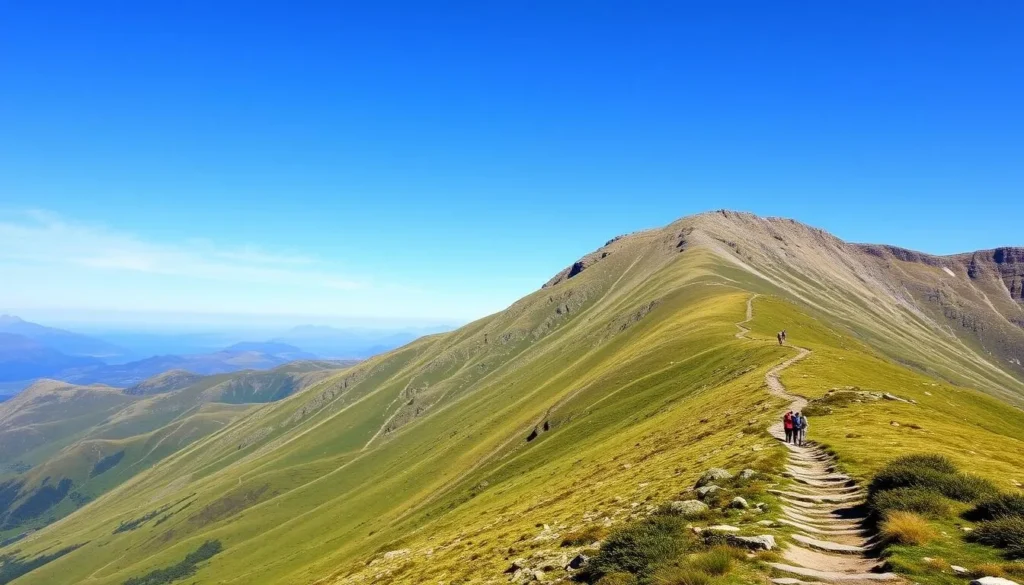
Recommended Seasons
Summer (June to August)
- Longest daylight hours (up to 18 hours)
- Warmest temperatures (10-20°C/50-68°F)
- Best visibility and clearest skies
- Busiest season with more crowded trails
Early Autumn (September)
- Fewer crowds than summer
- Generally stable weather
- Beautiful autumn colors
- Cooler temperatures (5-15°C/41-59°F)
Seasons to Avoid
Winter (November to April): Ben Nevis in winter is extremely dangerous and should only be attempted by experienced mountaineers with proper equipment and winter climbing skills. The mountain is frequently covered in snow and ice, with temperatures well below freezing and high winds. Avalanche risk is significant.
Weather Considerations
The weather on Ben Nevis is notoriously changeable. Even on a sunny day in Fort William, the summit can be shrouded in cloud, with temperatures near freezing and strong winds. Always check the mountain weather forecast before setting out.
Weather Fact: Ben Nevis experiences over 200 days of rainfall per year and is covered in cloud approximately 80% of the time.
Ready to Plan Your Trip?
Find the perfect accommodation for your Ben Nevis adventure, from cozy B&Bs to luxury hotels.
Getting Around Locally

Local Transport Options
- Local Buses: Shiel Buses operates services around Fort William and to nearby villages including routes to Glen Nevis.
- Taxis: Several taxi companies operate in Fort William, providing convenient transport to trailheads.
- Bicycles: Bike rentals are available in Fort William, including electric bikes from Hi-Bikes with stations around town.
- Walking: Fort William town center is compact and walkable, with the Ben Nevis Visitor Centre about 2 km from the town center.
Getting to the Trailhead
The main starting point for climbing Ben Nevis is the Ben Nevis Visitor Centre in Glen Nevis, approximately 2 km from Fort William town center. You can reach it by:
- Car: There’s a paid parking lot at the visitor center (often fills up early in peak season)
- Bus: Local Shiel Buses services run from Fort William to Glen Nevis
- Taxi: A short ride from Fort William town center
- Walking: Approximately 30-40 minutes from Fort William town center
Where to Stay
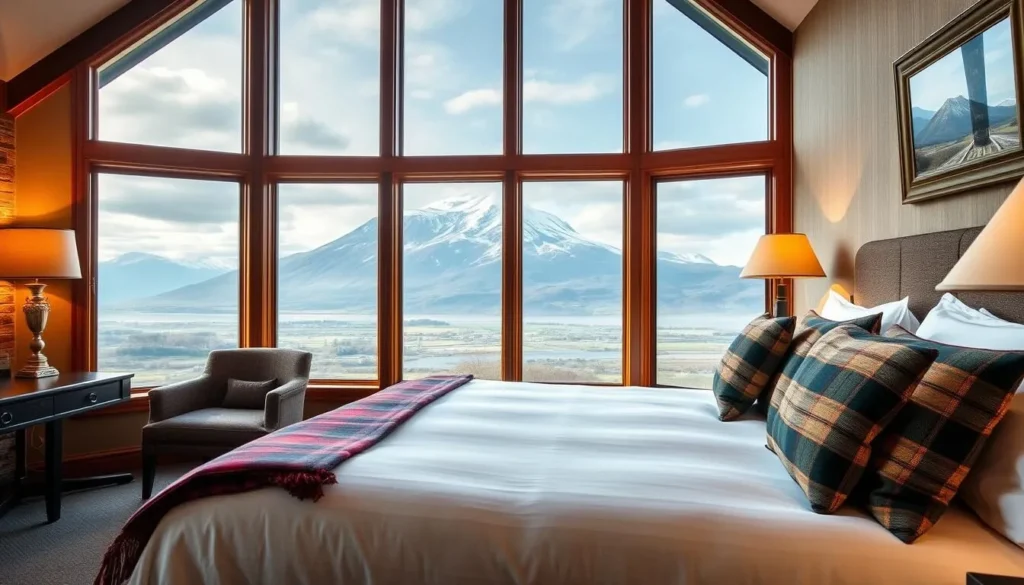
Fort William Accommodations
Fort William offers a wide range of accommodation options to suit all budgets and preferences. Staying in town gives you easy access to restaurants, shops, and transportation.
Budget Options
- Glen Nevis Youth Hostel
- Bank Street Lodge
- Fort William Backpackers
Mid-Range Hotels
- The Garrison Hotel
- Nevis Bank Inn
- Lime Tree Hotel
Luxury Stays
- Inverlochy Castle Hotel
- Moorings Hotel
- Kingshouse Hotel
Glen Nevis Accommodations
Staying in Glen Nevis puts you closer to the mountain and trailheads, surrounded by stunning scenery.
- Glen Nevis Campsite: Located near the foot of Ben Nevis with excellent facilities
- Ben Nevis Inn & Bunkhouse: Historic accommodation at the start of the Mountain Track
- Glen Nevis Holiday Park: Offers pods, caravans, and camping pitches
Find Your Perfect Stay Near Ben Nevis
Book early to secure the best accommodation options, especially during peak summer months.
Dining & Local Cuisine
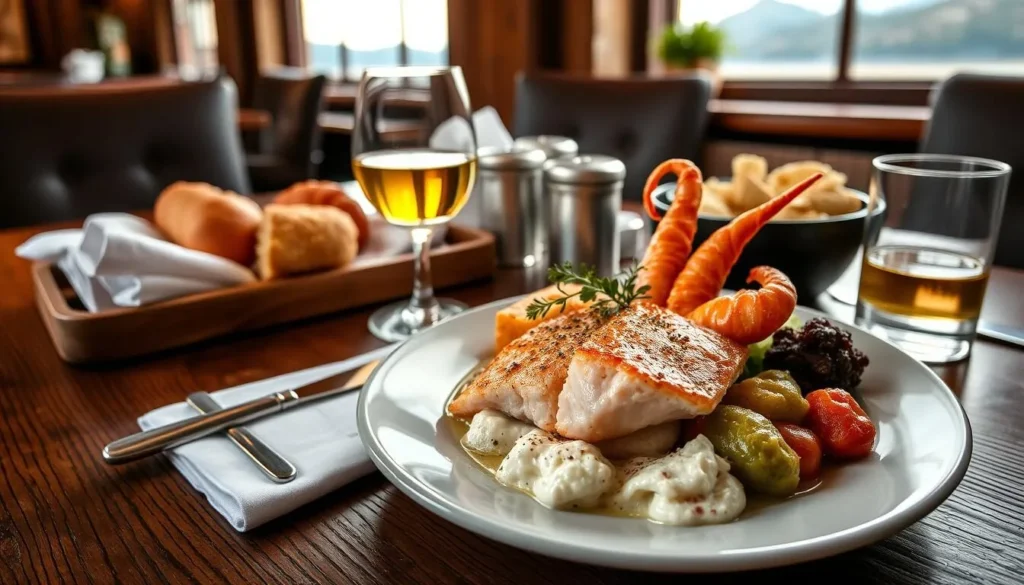
Fort William Dining Options
The Fort William area offers excellent dining options, from traditional Scottish fare to international cuisine. Here are some top picks:
Casual Dining
- The Geographer (Scottish pub food)
- Black Isle Bar (wood-fired pizzas)
- Blas Na Mara (seafood shack)
Mid-Range Restaurants
- Crannog Seafood Restaurant
- The Garrison West
- Lime Tree Restaurant
Fine Dining
- Albert Roux at Inverlochy Castle
- Lochside Restaurant
- The Grog & Gruel (upstairs)
Local Scottish Specialties
Don’t miss these traditional Scottish dishes during your visit:
- Seafood: Fresh langoustines, scallops, and salmon from nearby waters
- Haggis, Neeps & Tatties: Scotland’s national dish with turnips and potatoes
- Cullen Skink: Creamy smoked haddock soup
- Venison: Locally sourced from Highland estates
- Whisky: Try a dram from the nearby Ben Nevis Distillery
Post-Hike Refreshments
After conquering Ben Nevis, reward yourself at one of these hiker-friendly spots:
- Ben Nevis Inn: Located at the foot of the Mountain Track, offering hearty meals and local beers
- The Grog & Gruel: Popular pub in Fort William with an extensive whisky selection
- The Highland Cinema Café: Modern café with excellent coffee and cakes
Attractions, Sightseeing & Activities
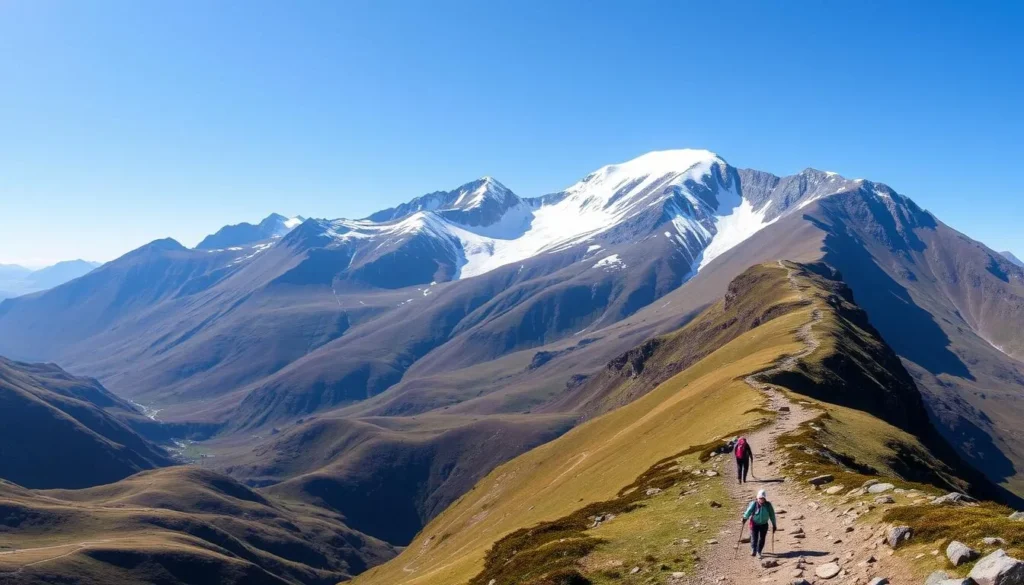
Climbing Ben Nevis: Main Routes
There are two main routes to the summit of Ben Nevis, each offering a different experience:
The Mountain Track (Tourist Route)
- Most popular and straightforward route
- 10.5 miles (17 km) round trip
- 1,345 m (4,413 ft) of ascent
- 7-9 hours for the round trip
- Starts from the Ben Nevis Visitor Centre
- Suitable for fit walkers with proper equipment
Carn Mor Dearg Arête Route
- Challenging ridge route for experienced hikers
- 10-11 hours round trip
- Includes scrambling across exposed sections
- Traverses two Munros
- Spectacular views of Ben Nevis’s North Face
- Starts from North Face car park at Torlundy
Safety First: Ben Nevis is a serious mountain that requires proper preparation. Always check the weather forecast, wear appropriate clothing and footwear, and carry essential equipment including map, compass, first aid kit, and emergency supplies.
Book a Guided Ben Nevis Hike
For a safer and more informative experience, consider a guided hike with a local mountain expert.
Beyond Hiking: Other Activities
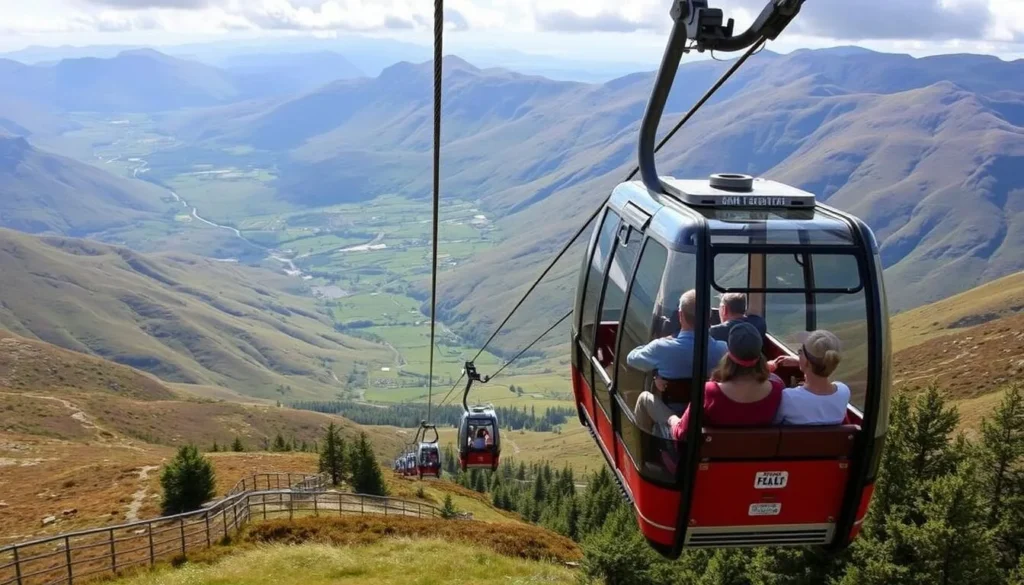
- Nevis Range Mountain Gondola: Take a scenic ride up Aonach Mor for breathtaking views
- Rock Climbing: The North Face offers world-class climbing routes
- Glen Nevis Walks: Explore beautiful trails including the path to Steall Falls
- Ben Nevis Distillery Tour: Learn about whisky production at one of Scotland’s oldest distilleries
- Boat Trips on Loch Linnhe: Spot seals and enjoy coastal views
Nearby Attractions

- Glenfinnan Viaduct: Famous for appearances in Harry Potter films, especially when the Jacobite Steam Train crosses
- Glencoe: Dramatic mountain scenery and hiking trails about 30 minutes from Fort William
- Neptune’s Staircase: Series of eight locks on the Caledonian Canal
- Old Inverlochy Castle: 13th-century castle ruins near Fort William
- Steall Falls: Scotland’s second-highest waterfall, accessible via a scenic hike in Glen Nevis
Explore More Activities Around Ben Nevis
Discover tours, activities, and attractions to make the most of your Highland adventure.
Museums, Cultural Spots & Festivals
Museums & Historical Sites
- West Highland Museum: Located in Fort William, featuring exhibits on Highland history and Jacobite memorabilia
- Treasures of the Earth: Europe’s finest private collection of crystals, gemstones, and fossils
- Glenfinnan Monument: Commemorates the 1745 Jacobite Rising
- Commando Memorial: Dedicated to the original British Commando Forces of World War II
- Highland Folk Museum: Open-air museum showcasing Highland rural life (in Newtonmore)
Cultural Experiences
- Ben Nevis Distillery Tour: Learn about traditional whisky production
- Highland Soap Company: Watch artisan soap being made using local ingredients
- Highland Bookshop: Independent bookstore with excellent Scottish literature section
- Traditional Music Sessions: Enjoy live Scottish folk music at pubs like The Grog & Gruel
Annual Festivals & Events
- Fort William Mountain Festival (February): Celebrating mountain culture with films, talks, and workshops
- Scottish Six Days Trial (May): International motorcycle trials competition
- Ben Nevis Race (September): Grueling hill running race to the summit and back
- UCI Mountain Bike World Cup (May/June): Held at Nevis Range, attracting top riders
- Highland Games (July/August): Traditional Scottish athletic competitions in nearby towns
Sports, Nature & Outdoor Experiences
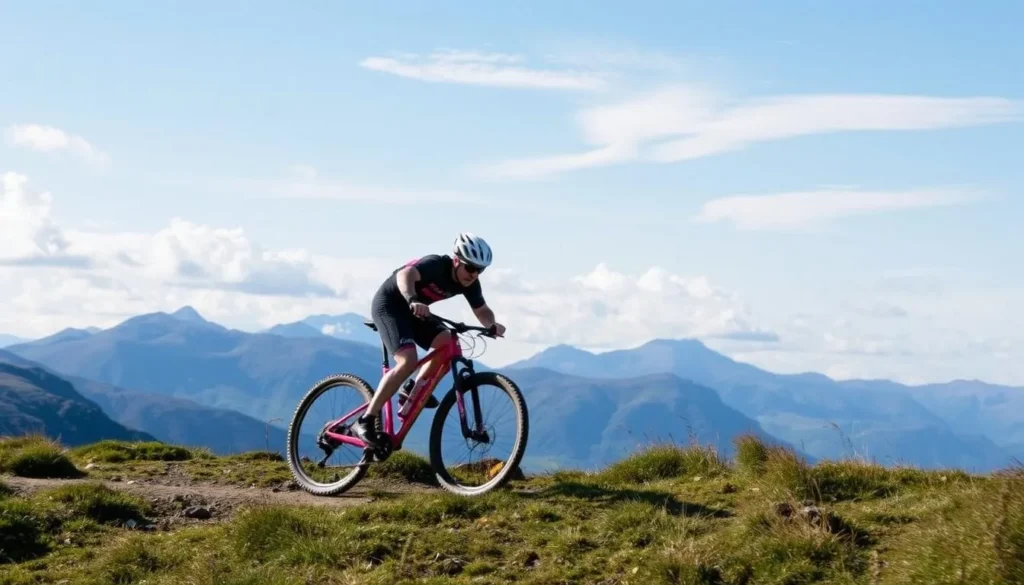
Outdoor Activities
The Fort William area is known as the “Outdoor Capital of the UK” for good reason. Beyond hiking Ben Nevis, there are numerous outdoor activities to enjoy:
Water Activities
- Canoeing on Loch Linnhe
- White water rafting on River Garry
- Wild swimming in Glen Nevis
- Fishing for salmon and trout
Mountain Activities
- Mountain biking at Nevis Range
- Rock climbing on Ben Nevis
- Winter skiing (seasonal)
- Paragliding
Other Adventures
- Gorge walking
- Zip-lining at Nevis Range
- Wildlife watching tours
- Photography expeditions
Nature Spots & Wildlife
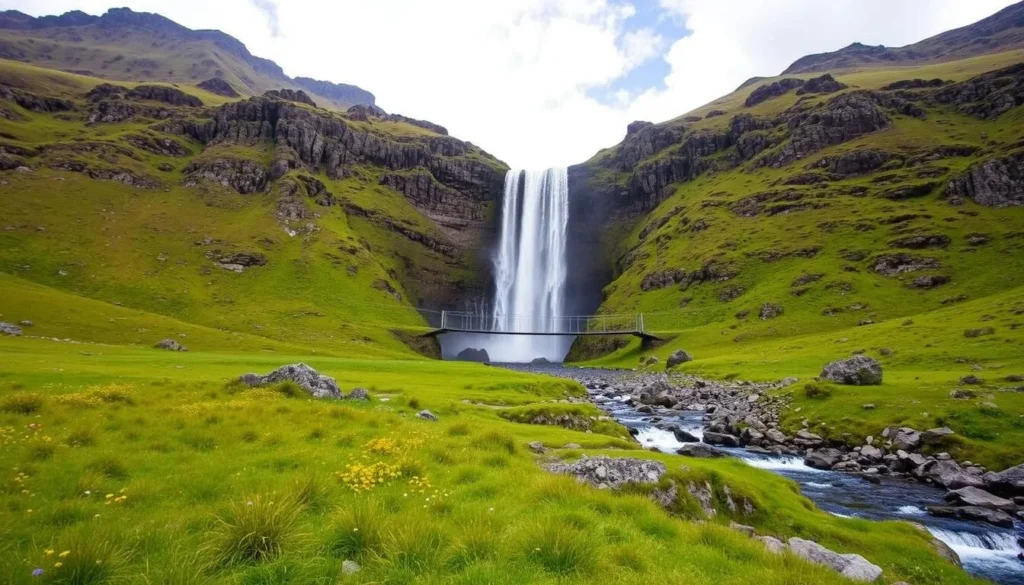
- Steall Falls: Scotland’s second-highest waterfall, accessible via a scenic 3.5 km hike
- Glen Nevis: Beautiful valley with riverside walks and dramatic scenery
- Cow Hill Circuit: Offers panoramic views over Fort William and Loch Linnhe
- Nevis Gorge: Dramatic rocky gorge with the River Nevis flowing through
- Wildlife to spot: Red deer, pine martens, golden eagles, and if you’re lucky, wildcats
Book Your Outdoor Adventure
From guided hikes to adrenaline-pumping activities, find the perfect outdoor experience.
Safety, Etiquette & Local Customs

Mountain Safety
Ben Nevis Safety Essentials:
- Check the mountain weather forecast before setting out
- Carry a map and compass and know how to use them
- Wear appropriate clothing and footwear (layers, waterproofs, hiking boots)
- Pack essential supplies (water, food, first aid kit, headlamp, whistle)
- Let someone know your route and expected return time
- Be prepared to turn back if conditions deteriorate
- Winter climbs require specialized equipment and experience
Outdoor Etiquette
- Leave No Trace: Take all litter back with you
- Stick to Paths: To prevent erosion and protect fragile ecosystems
- Close Gates: When crossing farmland
- Respect Wildlife: Observe from a distance and don’t disturb
- Scottish Outdoor Access Code: Familiarize yourself with your rights and responsibilities
Local Customs & Etiquette
- Tipping: 10-15% in restaurants is standard if service isn’t included
- Pub Etiquette: Order and pay at the bar in most pubs
- Whisky: It’s “whisky” not “whiskey” in Scotland (no ‘e’)
- Midges: These tiny biting insects can be prevalent in summer; bring repellent
- Weather Talk: Discussing the weather is a common conversation starter
Visitor Comments About Ben Nevis
“Climbing Ben Nevis was the highlight of our Scotland trip. The views from the top were absolutely breathtaking when the clouds parted. Make sure you’re prepared though – the weather changed dramatically several times during our hike!”
“We took the Mountain Track in July and while it was challenging, it was definitely manageable with proper preparation. The sense of achievement at the summit was incredible. Don’t underestimate the descent though – it’s tough on the knees!”
“We hired a guide for our Ben Nevis climb and it was worth every penny. Not only did we learn about the mountain’s geology and history, but we also felt much safer having someone experienced leading the way, especially when visibility dropped near the summit.”
Practical Travel Tips
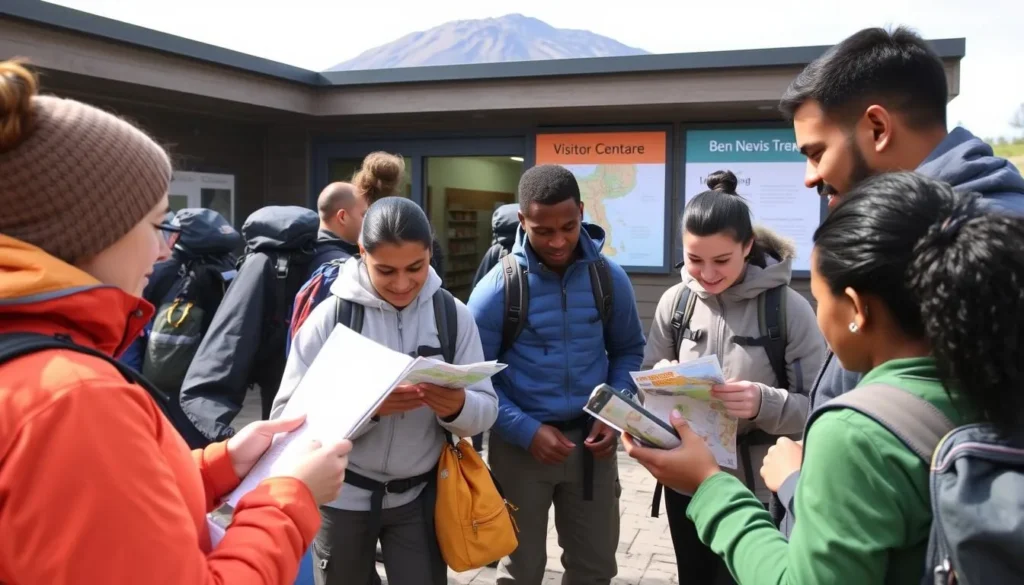
Essential Packing List
- Hiking boots with good ankle support and grip
- Waterproof jacket and pants (regardless of forecast)
- Layered clothing (avoid cotton, which retains moisture)
- Hat and gloves (even in summer)
- Map and compass
- First aid kit
- Headlamp or torch
- Food and water (at least 2 liters)
- Mobile phone (fully charged)
- Midge repellent (May-September)
Money & Connectivity
- Cash: While most places accept cards, carry some cash for smaller establishments
- Mobile Coverage: Signal can be patchy on the mountain; download maps offline
- WiFi: Available in most accommodations and cafes in Fort William
Useful Resources
- Ben Nevis Visitor Centre: Information, maps, and advice
- Mountain Weather Information Service: www.mwis.org.uk
- Walk Highlands: Detailed route descriptions
- Nevis Landscape Partnership: Conservation information
- Fort William Tourism: Local information and events
Ready for Your Ben Nevis Adventure?
Book your accommodations, tours, and transportation to experience the best of Ben Nevis and the Scottish Highlands.
Cruise Options

While Fort William itself doesn’t have a major cruise terminal, several cruise lines offer Scottish Highland itineraries that include stops at nearby ports, with excursions to Ben Nevis and Fort William available. These cruises typically navigate Scotland’s scenic west coast, offering a unique perspective on the Highlands.
Nearby Cruise Ports
- Oban: About 44 miles (71 km) south of Fort William
- Invergordon: Major cruise port for the Highlands
- Portree (Isle of Skye): Connected to the mainland near Fort William
Local Boat Trips
For a taste of cruising without the full ocean voyage, consider these local options:
- Loch Linnhe Cruises: Seal spotting and scenic tours from Fort William
- Crannog Cruises: Wildlife and sightseeing tours on Loch Linnhe
- Caledonian Canal Cruises: Trips along the historic canal
Explore Scottish Highland Cruises
Discover cruise options that include the Ben Nevis and Fort William area as part of a Scottish Highlands itinerary.
Conclusion
Ben Nevis offers an unforgettable Highland adventure that combines challenging hiking, breathtaking scenery, and rich Scottish culture. Whether you’re summiting the UK’s highest peak, exploring the charming town of Fort William, or enjoying the region’s outdoor activities, the Ben Nevis area provides experiences to suit all interests and abilities.
Remember that while conquering “The Ben” is a worthy goal, the journey itself—through ancient glens, alongside rushing rivers, and among Scotland’s most dramatic landscapes—is equally rewarding. With proper preparation, respect for the mountain, and an adventurous spirit, your Ben Nevis experience will surely become a highlight of your Scottish travels.
So lace up your hiking boots, pack your waterproofs (regardless of the forecast!), and prepare for an adventure on Scotland’s most iconic mountain. The roof of Britain awaits!
The above is subject to change.
Check back often to TRAVEL.COM for the latest travel tips and deals.
